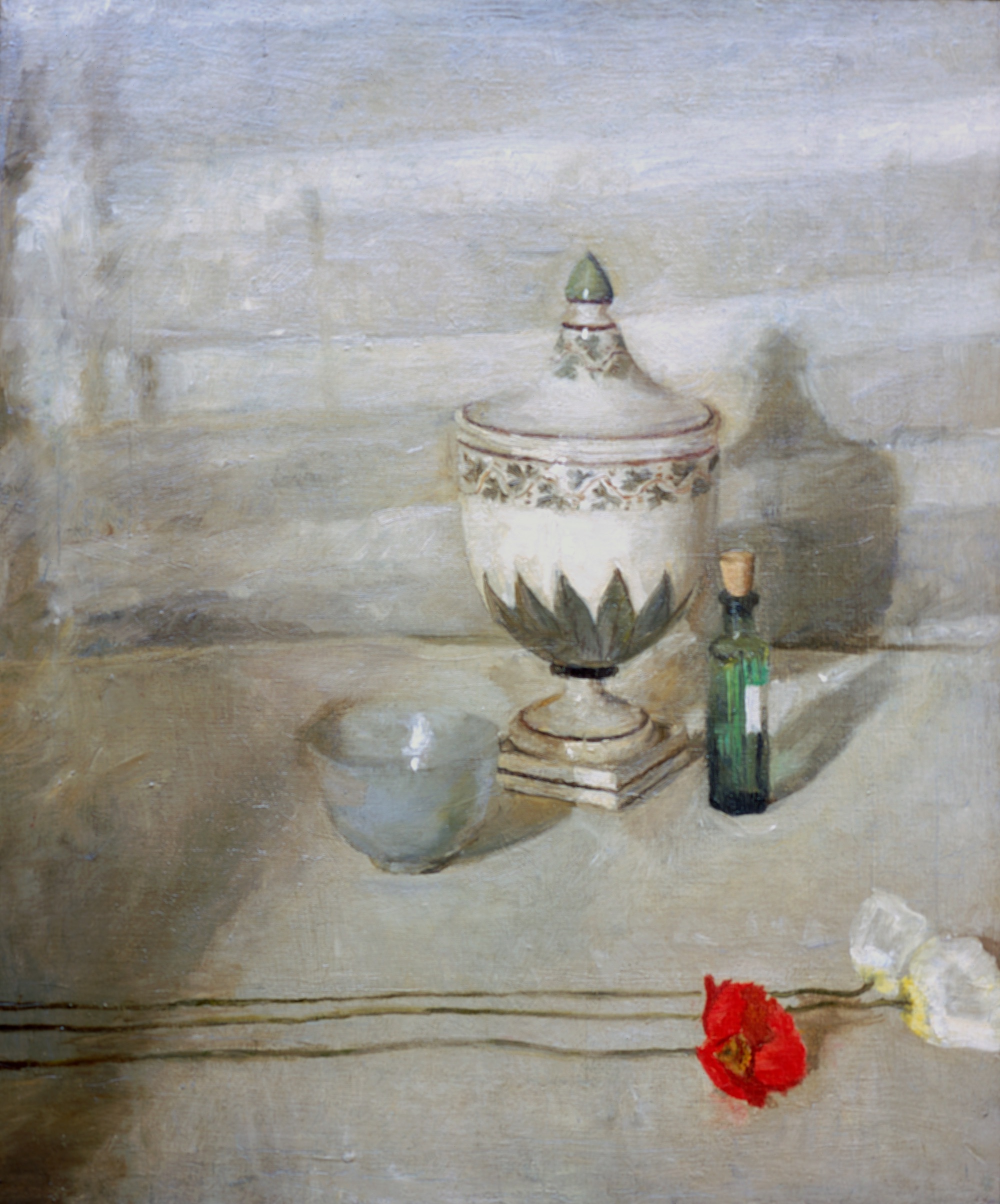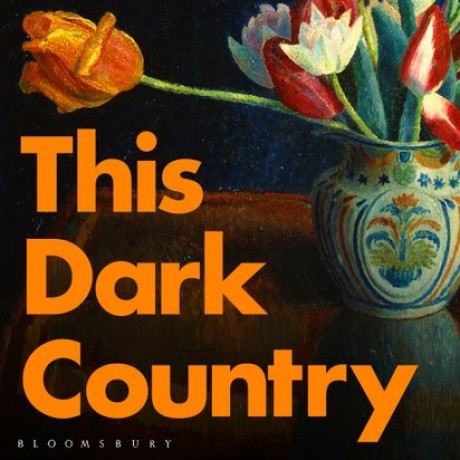
The artist Gwen John repeatedly depicted the rented rooms she occupied during her life in Paris—among them the attic of the 18th-century Hôtel de Montmorency on the rue de Cherche-Midi in Montparnasse. In A Corner of the Artist’s Room in Paris, morning light leaks through a window onto some ordinary objects.
“Gwen smears her presence over every one of these objects, in the chair she sits in, in the parasol she opens against the sun, in the navy shawl veined with gold she wears against the cold,” writes Rebecca Birrell in her beautiful, bold new book, This Dark Country: Women Artists, Still Life and Intimacy in the Early Twentieth Century. “Gwen loved this room, the harmoniousness of the life she made here, and that love is the painting’s real subject. The painting is like hair sealed in a locket, or a photograph tucked in a purse, a form of preserving the beloved at the height of feeling.”
This Dark Country is born out of Birrell’s interest in “how emotion circulates, how feeling transcends particular people, places and periods, and makes itself known to others”. A blend of group biography and art criticism, it explores the desires and ambitions of 20th-century women artists through their still life paintings.
More than descriptions, such paintings are distilled narratives, “a charting of spaces, objects and experiences tantamount to a map of the artists’ most tender, troubling moments”. They are always more than they appear, “these oranges, lemons, sparsely furnished rooms, saucepans, lilies, cups of tea”. Birrell argues that still life “took the rough, raw material of a life and reissued it as compacted, densely coded dramas on the trials of intimacy and of needs hungering at the seams of quotidian concerns”.
“Paintings are distilled narratives, a charting of spaces, objects and experiences tantamount to a map of the artists’ most tender, troubling moments”
Like the paintings of her women artists, Birrell’s book offers what she describes as a series of moments “in which the emotional issues and artistic practices that possessed them for decades were condensed”. Divided into ten chapters, it draws on previously unpublished archival material, including personal (and at times cryptic) letters. The paintings are more than descriptions, but Birrell describes them brilliantly: a “pink and frilled” bonnet resembles a “rare, delicate cabbage” and a swan has a “sneeze of yellow for a beak”; a bookshelf rises behind a woman “like her thoughts made visible”.
She pays attention not only to women’s art, but to their interests, habits, routines—the fact that Mary Katherine Constance Lloyd had a taste for salad dressing and Nina Hamnett liked to unwind after a long day with a glass of chilled white wine. Also, their lovers and friends. Loosely connected, the women shared concerns about art and gender and were “either queer, or living awry to heteronormativity in some key sense”. They decided on their own terms what constituted an agreeable life and what would nourish their art.
Dora Carrington, who escaped from her family’s “tiny sludge-coloured lounge in Bedford” when she won a scholarship to the Slade School of Fine Art, London, was uninterested in the conventional roles of daughter, lover, wife—and it was this disinclination that fuelled her playful paintings.
In Staffordshire Dogs, she pokes fun at the way that two identities can within a couple collapse into one another. The dogs are “heavy and static, fragile enough to shatter if dropped; they are cute and silly and unfrightening”—not unlike the “self-consciously faulty” relationship between Carrington and Lytton Strachey. In Eggs on a Table, there is a hopefulness to the way three eggs fit together “in a simple and frictionless arrangement”. By this stage, Carrington had uneasily accepted a proposal from Ralph Partridge, but still wished to continue her “version of marriage” with Lytton.

Birrell states early on that she’s using art as a medium for thought rather than a transcription of a woman’s inner life. Hers, she writes, is a “loose and intuitive interpretative method”. She’s more interested in possibility than proof, which is fortunate since the archival material she has to work with is often limited.Some queer women, including Carrington, sought out modes of disappearance. Lesbianism in the early 20th century was regarded as something best ignored, unadvertised, and women like Ethel Sands became masters of “ambiguity and evasion”. The empty, clean interiors that define her work highlight how “as a queer woman it was not enough to reveal little—next to nothing even; if you wanted to be safe it was necessary to give the impression of not existing at all”.
Birrell also acknowledges that the work of her women artists was mixed up with marginalisation and privilege. “These women’s lives did not yield the simple narrative of triumphant heroism that I perhaps unconsciously wanted from them when I began researching this book,” she writes candidly. “They were (as most lives likely are) defined by their disappointments and errors of judgement as much as they were by their more palatable or radical interests and achievements.”
“Her rebellion against domestic order didn’t include renouncing the wealth of her parents, who became the reluctant patrons of her subversion”
For Gluck (an androgynous contraction of the artist’s surname, Gluckstein) creativity offered an escape from the confines of femininity and family. And yet, her rebellion against domestic order didn’t include renouncing the wealth of her parents, who became the “reluctant patrons of her subversion”. Gluck was unpleasant to her servants, whose labours, Birrell writes, lent her paintings of polished surfaces, scrubbed floors, and dusted cabinets their defining aesthetic. Theirs was “an unintentional collaboration, no gratitude or recompense”.
Vanessa Bell is often admired for the way she juggled motherhood, lovers and art. “But it is clear how such a full and various life was achieved,” writes Birrell, “her meals purchased and cooked for her, her children cared for, and her house swept and cleaned by others, for decades.” Birrell lists all of Vanessa’s female domestic servants and says their names should be on gallery labels.
This Dark Country (a name lifted from Virginia Woolf’s Women and Fiction, and which refers to a woman’s life, her day) is about the relationship between genre, gender, value, work and domesticity. A relationship that extends beyond these women artists to the spaces, objects, and individuals around them—the things that bore witness to their lives, and which were anything but still.
Chloë Ashby is an author and arts journalist. Her first novel, Wet Paint, will be published by Trapeze in April 2022
This Dark Country: Women Artists, Still Life and Intimacy in the Early Twentieth Century by Rebecca Birrell
Published by Bloomsbury, out now
VISIT WEBSITE





